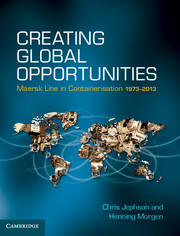Book contents
- Frontmatter
- Dedication
- Contents
- List of figures
- List of tables
- List of Economist Intelligence Unit data
- List of boxes
- Acknowledgements
- Glossary
- Prologue
- 1 ‘Per Aspera Ad Astra’
- 2 The Coming Revolution
- 3 The Decision
- 4 Building the Base (1978–1984)
- 5 Planning the Next Steps (1984–1987)
- 6 Laying the Foundations for Expansion (1987–1990)
- 7 The 1990s
- 8 The Acquisition Trail (1992–1998)
- 9 1999 A Year of Developments and Acquisitions
- 10 Into the New Millennium (2000–2005)
- 11 P&O NedLloyd (2005–2007)
- 12 A New Strategy (2008–2013)
- Epilogue
- Notes and References
- Index
9 - 1999 A Year of Developments and Acquisitions
Published online by Cambridge University Press: 05 April 2014
- Frontmatter
- Dedication
- Contents
- List of figures
- List of tables
- List of Economist Intelligence Unit data
- List of boxes
- Acknowledgements
- Glossary
- Prologue
- 1 ‘Per Aspera Ad Astra’
- 2 The Coming Revolution
- 3 The Decision
- 4 Building the Base (1978–1984)
- 5 Planning the Next Steps (1984–1987)
- 6 Laying the Foundations for Expansion (1987–1990)
- 7 The 1990s
- 8 The Acquisition Trail (1992–1998)
- 9 1999 A Year of Developments and Acquisitions
- 10 Into the New Millennium (2000–2005)
- 11 P&O NedLloyd (2005–2007)
- 12 A New Strategy (2008–2013)
- Epilogue
- Notes and References
- Index
Summary
Containerisation was growing, it was exciting, we were really led by a lot of shrewd, tough, smart people. You know, we had no capital, nothing really behind us except our own energy. There was no model for us to follow. It was interesting, stimulating and exciting.
John Clancey, President of Sea-LandWriting in Containerisation International’s 1997 yearbook, John Fossey started his article by stating:
The container liner industry appears to be heading for the rocks. With no appreciable pick-up in the level of scrappage, with freight rates in the major trades lower in real terms than they were 10, even 20 years ago in some cases, and with trading volumes likely to grow by eight per cent a year at best to the end of the decade, how can the industry genuinely support a record order book equivalent to 22 per cent of the existing fleet?
With market volumes growing at about 8 per cent a year and a number of development opportunities still in front of it, Maersk Line’s plan was to grow by about 10 per cent a year for the next three years and thereafter with the market. The target was for Maersk Line to be achieving a weekly turnover of $100 million, or a minimum annual turnover of $5 billion, by December 1998, while from 1999 growth was to be organic. The vessel-sharing agreement (VSA) with Sea-Land was considered important, but to ensure long-term operational viability, separate plans were also being made by each service to be able to develop independently of the VSA, if necessary.
- Type
- Chapter
- Information
- Creating Global OpportunitiesMaersk Line in Containerisation 1973–2013, pp. 251 - 275Publisher: Cambridge University PressPrint publication year: 2014



